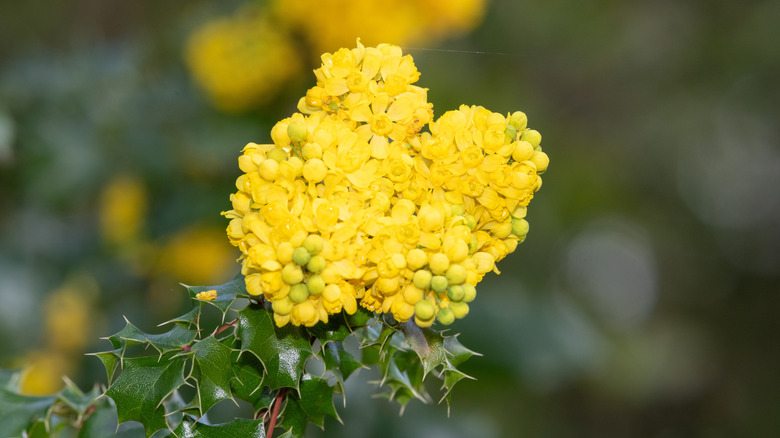The Low-Maintenance Shrub That Keeps Hummingbirds Visiting In Snowy Weather
Most hummingbirds migrate to Mexico and Central America to spend the winter. But some, like Anna's hummingbird, stay in the U.S. all year-round. For them, though, winter is not exactly an easy time. They need food and a lot of it to fuel their small yet metabolically very active bodies. But in winter, most sources of nectar, like flowers, and tiny bugs that these always-hungry creatures need to eat are gone. That's when our gardens can make all the difference. But the problem is that not many plants flower in winter, so what can you do? Well, don't worry. Oregon grape (Berberis aquifolium), otherwise known as tall or creeping Mahonia, can help.
It is an easy and low-maintenance shrub you can plant in your garden in winter. It is one of those flowering perennials that can withstand frigid winters and will keep attracting hummingbirds even in snowy weather. It can be grown anywhere in USDA Plant Hardiness Zones 5 to 8, and in midwinter, it lights up the garden with its brilliant yellow flowers that attract hummingbirds. And the best part? The flowers don't just come and go. They can live for several weeks, lasting until early spring. But the benefits of Oregon grape don't just end here. Its flowers are followed by blue-black berries, which can help you attract more songbirds to your yard, like robins and finches, and you can use them in jams and jellies too.
How to plant and care for Oregon grape
Luckily, mahonias are easygoing plants. They can be grown in most gardens and need little attention. But if you want them to really thrive, you will need to do a few things just right. For instance, where you should plant it for the best winter blooms. Start by choosing a sheltered spot. Plants that grow near the buildings get the benefit of a warm microclimate that can help protect buds and flowers during cold spells. A south- or west-facing wall works the best.
Placing near the wall is also the right thing to do as it protects its flowers from full sun, which can bleach them, but still gives a few hours of light that they need to bloom. And if you know anything about the features for attracting hummingbirds to your garden, you must know they don't like the bleached-out white colors at all. Other than the location, you also have to be mindful of the soil pH when planting your Oregon grape plants. If the pH is high, it can lead to chlorosis, which might make your plants even duller and unattractive to the hummingbirds.
The soil also needs to be moist but well-drained and organically rich. So, consider adding a bunch of leaf compost or rotted manure, whatever you can find easily, to the soil. Rotted manure and leaf compost will not only increase the soil fertility but also help lower the pH, which these plants need. Don't add fresh manure, though, as it can contain pests and fungal spores. Oregon grape plants are susceptible to many pests and fungal diseases.

